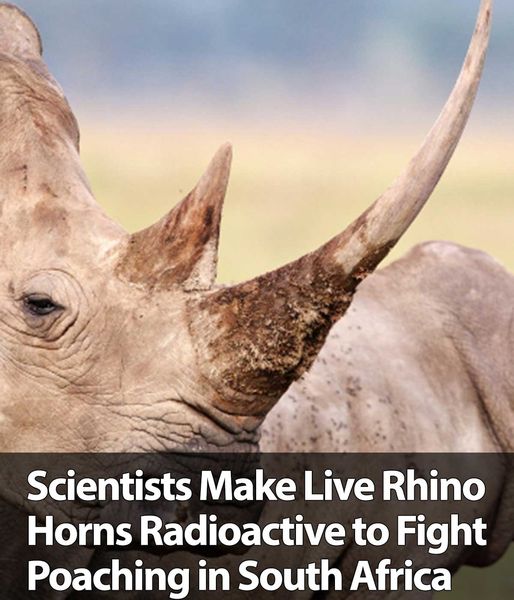South Africa is home to most of the rhinoceros in the world. However, experts are concerned that will change in the near future. Poaching is becoming more common, despite the country’s efforts to stop it. As of early 2024, South Africa has about 2,000 black rhinos classified as “critically endangered,” and 13,000 “near threatened” white rhinos. So scientists initiated a new plan to curb poaching: injecting radioactive material into rhino horns so border posts can detect them more easily.
South Africa’s Rhino Poaching Crisis

Because of South Africa’s large rhino population, poachers flock there to hunt and profit from the high demand in Asia where the horns are used in traditional medicine. Like human hair and nails, rhino horns can regrow but poachers choose to kill the animals instead of sedating them to get the contraband.
“Every 20 hours in South Africa a rhino dies for its horn,” said James Larkin, director of the University of the Witwatersrand’s radiation and health physics unit. “These poached horns are then trafficked across the world and used for traditional medicines, or as status symbols. This has led to their horns currently being the most valuable false commodity in the black-market trade, with a higher value even than gold, platinum, diamonds, and cocaine.”
Hurting the Illegal Trade

Almost 10,000 rhinos in South Africa have been killed by poachers since 2008. In 2023 alone, there were 499 confirmed cases. Overall, wildlife trafficking is the third largest global organized crime. The researchers from the University of the Wit hope that hurting the trade might eventually stop poachers from killing rhinos.
“Sadly, rhino horns play a large role in funding a wide variety of criminal activities globally,” Larkin said. “Ultimately, the aim is to try to devalue rhinoceros’ horn in the eyes of the end users, while at the same time making the horns easier to detect as they are being smuggled across borders.”
Anti-Poaching Radioactive Chips

Larkin led an initiative that could help dissuade smugglers and hunters. He placed two small radioactive chips into the horns, making them dangerous to humans and useless to anyone trying to profit from them. Meanwhile, the dose of radioactive material is too low to affect the creature’s health or environment.
The Radioisotope Procedure

Twenty rhinos at the Limpopp Rhino orphanage became part of the Rhisotope project. During the procedure, the rhinos are put to sleep and don’t feel any pain as Larkin drills a small hole into the horn before hammering in the radioisotope. Its dose is strong enough to set off detectors at international border posts, where agents routinely search for contraband. The material should theoretically stay in the horn for about five years.
“Safe for Rhinos”

The team will plant signs all around the property, warning prospective poachers, and they will also educate the locals about their initiative. According to the Rhisotope website, people who ingest these horns will not be harmed unless they consume an entire one. “The intention is not actually to harm the end user but to use their natural fear of radioactive materials to dissuade them from wishing to purchase or otherwise acquire radioactive horn,” the team explains. Additionally, veterinary surgeons who treat the rhinos won’t be harmed by the radiation unless they spend hours tightly gripping the horn.
Rhino experts will observe the animals daily for the next six months. They will take blood samples at the beginning and end of this period. If the test is successful, the team hopes to use their radioisotopes to help other endangered species such as elephants and pangolins.
Anti-Poaching Hounds

Traditionally, hounds have been used to help people hunt animals. But in 2018, Joe Braman trained his free-running hounds to chase armed rhino poachers around the Kruger National Park. This unique anti-poaching team began with Theresa Sowry, CEO of the Southern African Wildlife College visiting Braman in Texas in 2017. At that point, his black and tan hounds aided law enforcement in finding escaped prisoners.
During the training process, Braman became particularly incensed about the poaching crisis after seeing a video of a rhino dying after its horn was axed off. “He was aspirating on his own blood!” Braman says. “I don’t think I have ever seen anything as horrific… I believe in reaction. You do something—that means I’m gonna do something twice as bad to get you back. Some of these people are recklessly killing two or three rhinos a night. That’s a war. And all is fair in war.”
However, the dogs were trained to act aggressive but not to attack. Rather, they intimidate the poachers into dropping their weapons while trying to escape and detain them long enough for law enforcement to arrive.
Animals Will Remember

Animal lovers may applaud Larkin and Braman for their conservation efforts, but the true reward is their success in protecting animals and watching their populations increase. But sometimes the animals themselves acknowledge their protectors. Lawrence Anthony, a conservationist known as the Elephant Whisperer, passed away in 2012. He had worked to rescue and rehabilitate wild elephants, and in a stunning display of gratitude, the elephants walked over 12 hours to his home in the South African province of KwaZulu-Natal and stood vigil for two days. They hadn’t visited his home for over a year and a half, but Jason, Anthony’s son, says he believes they had sensed the death.
Elephants are known to mourn their dead loved ones and even hold “funerals” for them. And it seems that this herd recognized the man who had helped them and paid him the respects they usually only give to their kin.
